Introduction
Last week, I built probabilistic models that used binomial logistic regression to predict a distribution of statewide election results based off of historical results and random draws that represent possible rates of voter turnout. However, one flaw of this model is that it ultimately used only one value to represent the turnout rate of the voting eligible population (VEP), while the actual range of possibilities for the turnout rate (nationally or for any given state) could be represented by a range of possible values bounded by a maximum and minimum informed by historical data and recent trends. Thus, I decided to explore historical trends in presidential election turnout by state and expanded upon my models from last week to more accurately reflect expected 2020 turnout rates for the presidential election.
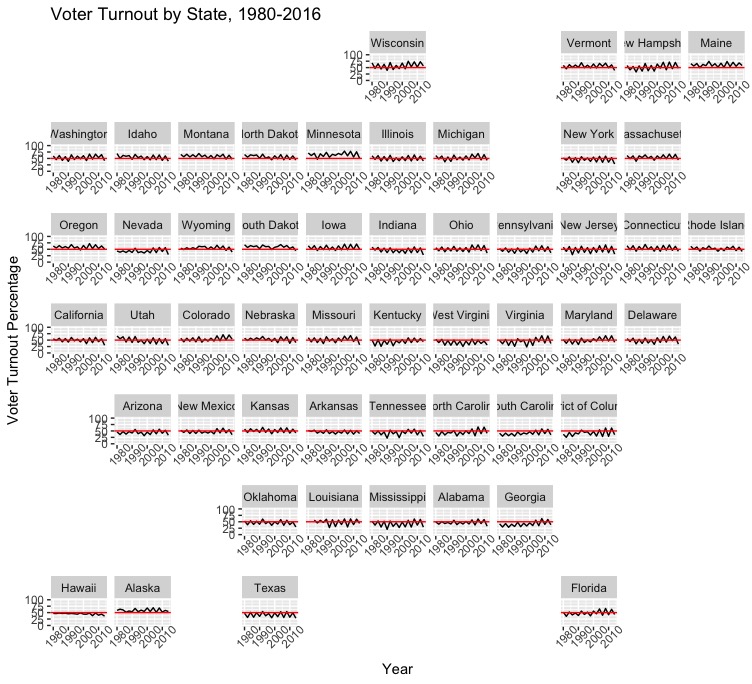
Above, see a geofaceted plot that shows the historical state turnout rates for all federal elections from 1980-2016. The 50% mark is highlighted by a red line, and as you can see, most states consistently have a voter turnout that is somewhere around 50%. Some states, like Minnesota, tend to have higher than average voter turnout, and other states, such as Tennessee, tend to have lower than average voter turnout. While it is impossible to predict the exact turnout rate for the upcoming 2020 election, we can pretty confidently say that the voter turnout rate won’t be 30% or 80%. If anything, it would make the most sense if it was between 50 - 60%, as the 2016 presidential election saw a turnout rate of 55.5% and the 2018 midterm elections saw a record-breaking turnout of 49.3% (Which was the highest turnout for a midterm election in the past century). Over the course of presidential elections from the past 50 years, the lowest turnout rate was 49% and the highest was 60.7%.
National Model
Based on analysis of historical trends in voter turnout, I updated my probabilistic models from last week in order to set boundaries for possible Republican and Democratic turnout so that my predictions will more accurately reflect the likely reality of the 2020 election. I created two national models (both with minimum turnout set at 0.45, which would represent very low turnouts in modern history) that give turnout advantages to Democrats and Republicans in order to see how these advantages would affect state outcomes. Based on my research, it seems that there is not comprehensive data on voter turnout by party, so for the first model, I set maximum Democratic turnout to 0.6 and maximum Republican turnout to 0.5. This would reflect an election where Democrats are particularly energized, while Republicans are around the same or slightly less likely to vote than they were in 2016. For the second model, I set maximum Democratic turnout to 0.5 and maximum Republican turnout to 0.7, which would reflect a night where Democrats were as unenthusiastic or more unenthusiastic than 2016 and where Republicans have record-breaking turnout (I don’t necessarily think that such a high Republican turnout, especially relative to Democratic turnout, is realistic, but this gap helped better illustrate the advantage that the Republicans would need to successfully compete for the electoral college).
| Democratic Advantage | Republican Advantage |
|---|---|
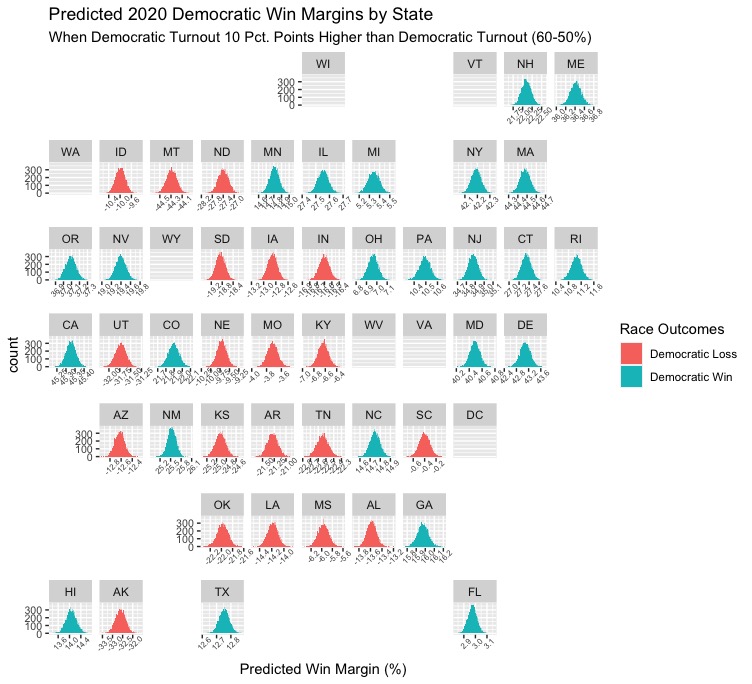 |
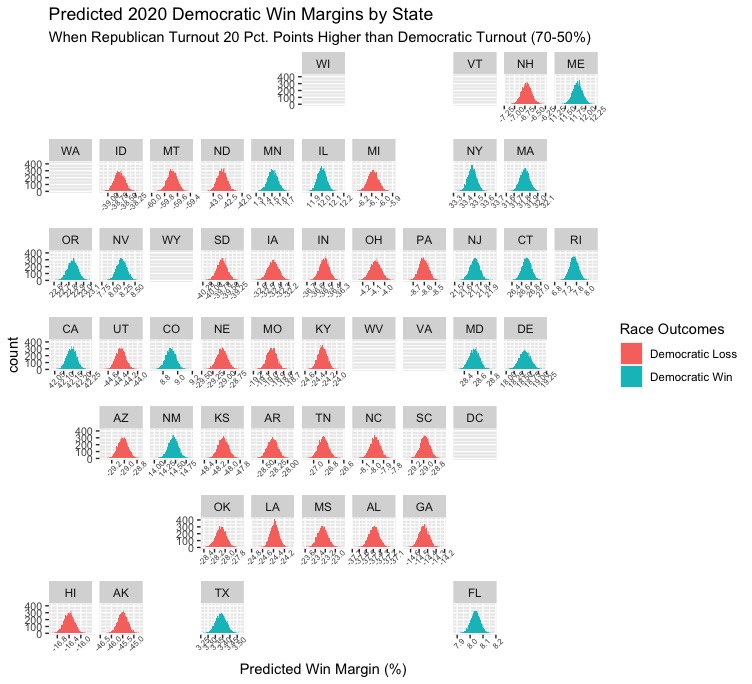 |
These models are pretty interesting. The first model predicts that the Democratic turnout advantage, while smaller than that of the advantage given to Republican turnout in the other model, will have a massive impact on the winner of the electoral college. Not only would Democrats win back states they lost to Republicans in 2016 (Michigan, Pennsylvania, Florida), but they would also win historically red states like Georgia and Texas. For the Republican turnout advantage model, the predictions do not paint quite as optimistic of an outlook for the party in question. Even though Republicans would hold states that went red in 2016 with a 20 point turnout advantage, my model predicts that some states would still flip blue, such as Texas. Still, the model predicts that Republicans would be able to flip some unexpected states (Hawaii, New Hampshire). Now, I’m going to analyze the three states I took a closer look at last week to see if my updated model yields any different predictions.
Texas
Historical Turnout | Model Prediction
:————————-:|:————————-:
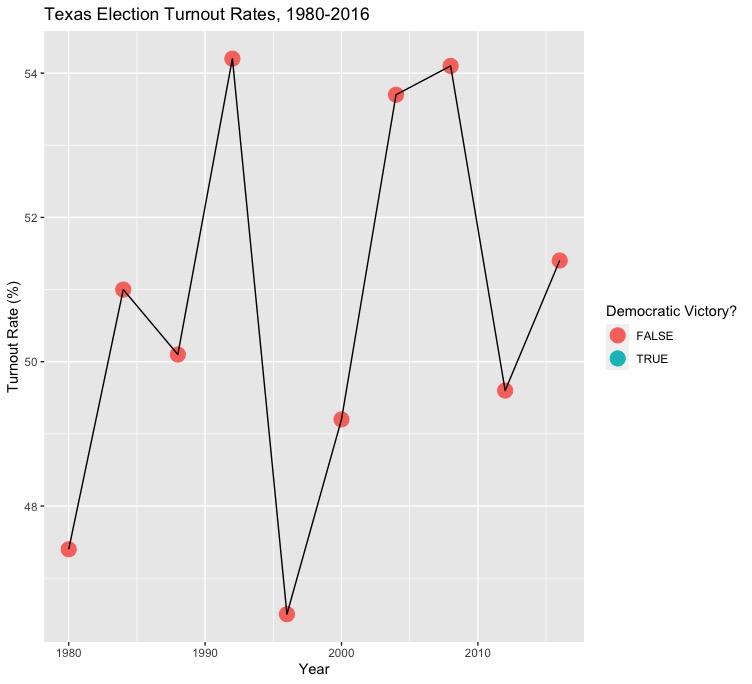 |
| 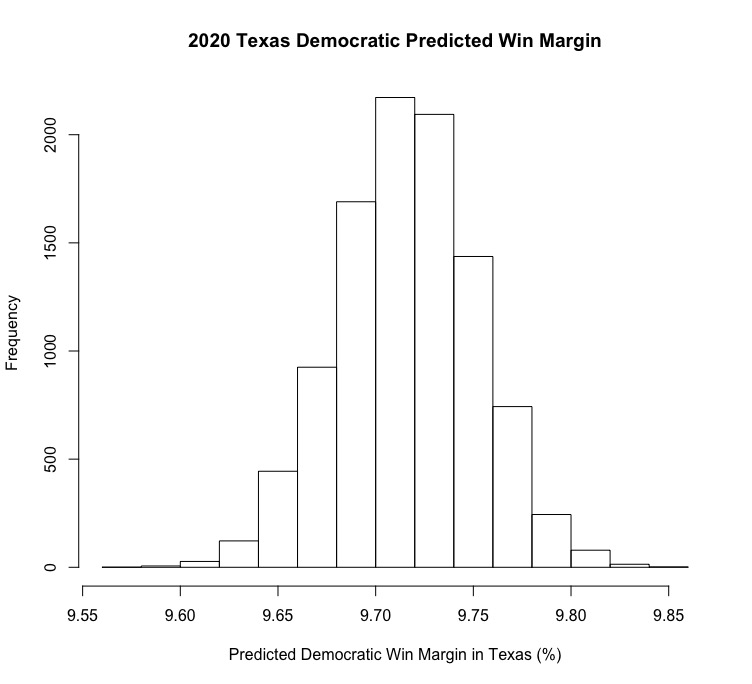
First, let’s take a look at historical turnout in Texas. Turnout is not especially high on average, with a minimum turnout of a little over 40% and a maximum turnout of around 55% of voters from 1980-2016. In my model, I gave the Democrats and Republicans a minimum turnout rate of 0.45 and a maximum turnout rate of 0.6 for Republicans and 0.65 for Democrats. Voter registration in Texas since the 2016 election makes it seem as though the Democrats could see record turnout in Texas in 2020, and Republican turnout may also be particularly high given Trump’s relative popularity in the state as well as a Republican incumbent senator’s re-election bid. However, my model predicts that Biden will win Texas by about 10 percentage points, so it appears that factoring in more realistic bounds for turnout is only likely to help Biden and the Democrats.
Arizona
| Historical Turnout | Model Prediction |
|---|---|
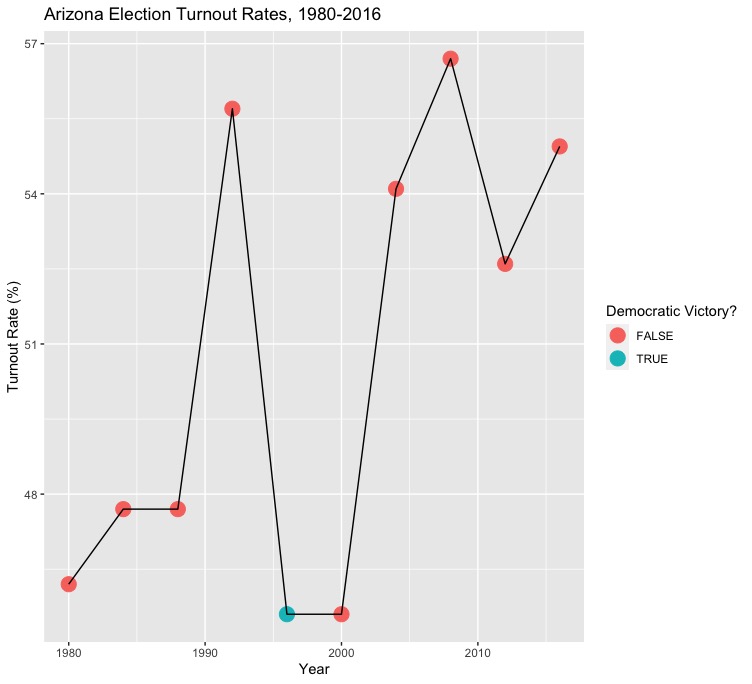 |
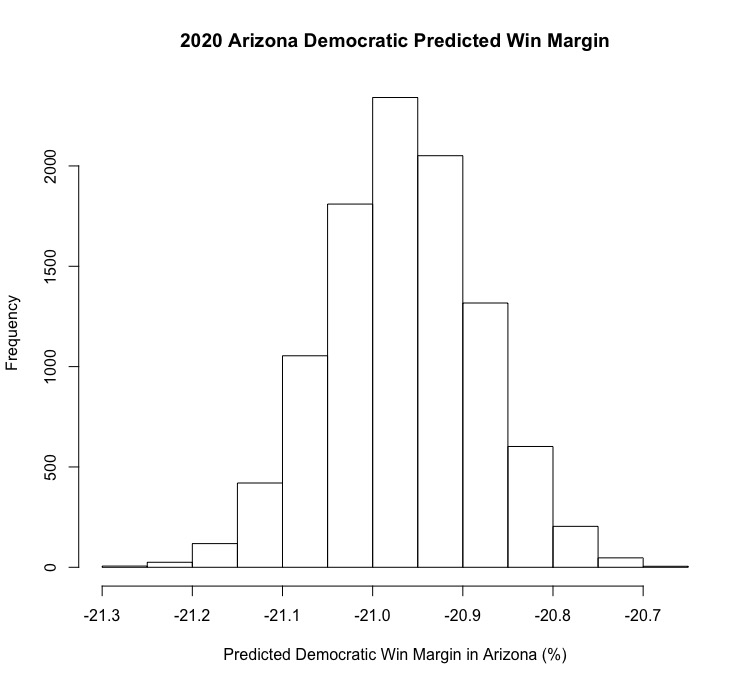 |
Last week, my model had Biden losing Arizona by nearly 20 percentage points, which surprised me greatly considering Biden’s polling advantage in the state as well as polls showing Democratic Senate candidate Mark Kelly with a sizeable lead in the polls. However, this week’s model is even less optimistic for Biden, and has Trump winning Arizona by over a 20-point margin. Historically, turnout in Arizona ranges from around 0.4 to 0.57, so I set the minimum turnout for both parties as 0.45 and the maximum turnouts as 0.55 and 0.6 for Republicans and Democrats, respectively. Still, Republicans hold a registration advantage in Arizona, so that could partially explain why the model became even less confident in Biden’s chances.
Florida
Historical Turnout | Model Prediction
:————————-:|:————————-:
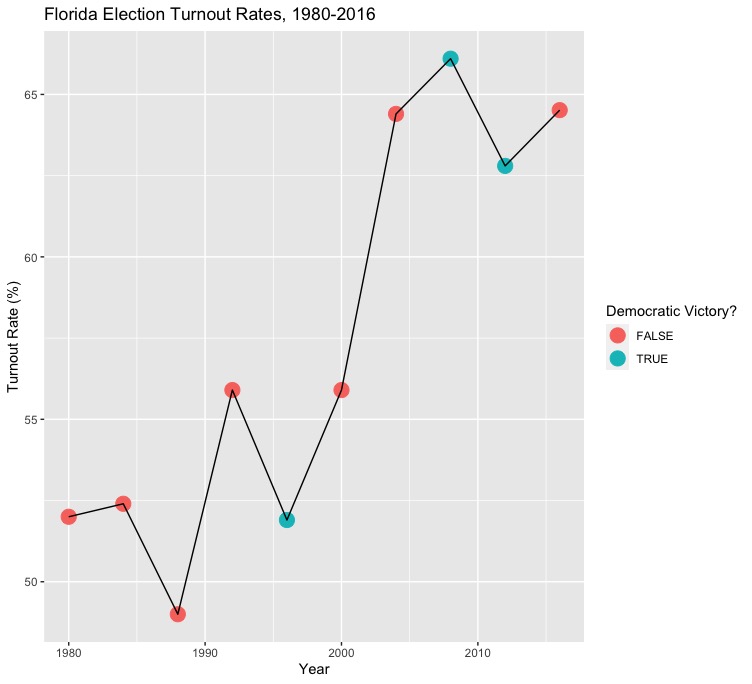 |
| 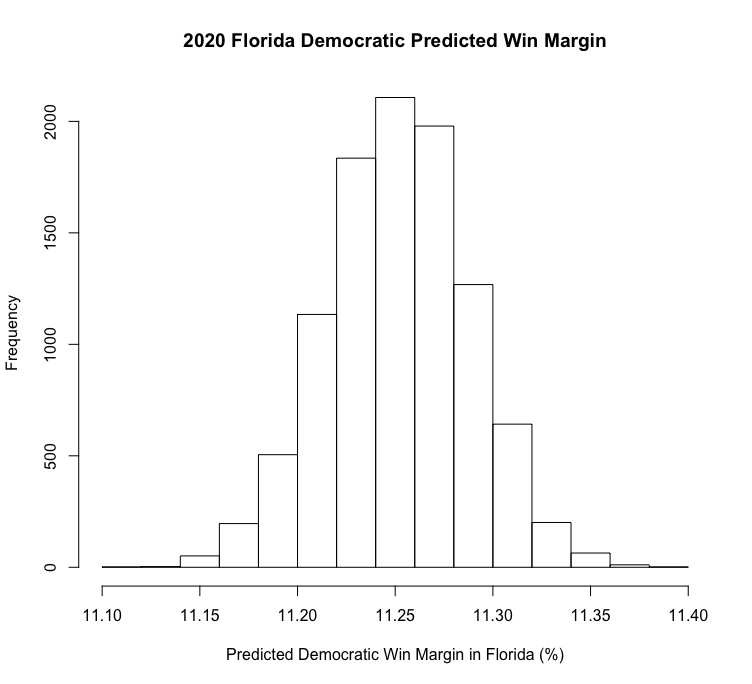
Out of all three states I looked at this week, Florida has the largest range in terms of minimum and maximum historical voter turnout (a minimum of around 0.45 and a maximum of around 0.65). As a result, I set minimum turnout in the state for both parties to 0.45 and a maximum of 0.65 for the Republicans and 0.7 for the Democrats. The model became even more optimistic for Biden as as a result, predicting a Democratic win margin of around 11 points. This doesn’t exactly seem realistic, but it would make sense that Biden’s lead would grow with a Democratic turnout advantage, as Democrats have around a two point advantage in terms of partisan affiliation in the state. Ultimately, it seems as though the small improvements to my model made it more accurate, but more indicators aside from polling averages should be included to more accurately reflect the complexity of factors influencing turnout and voting behavior in the 2020 election.